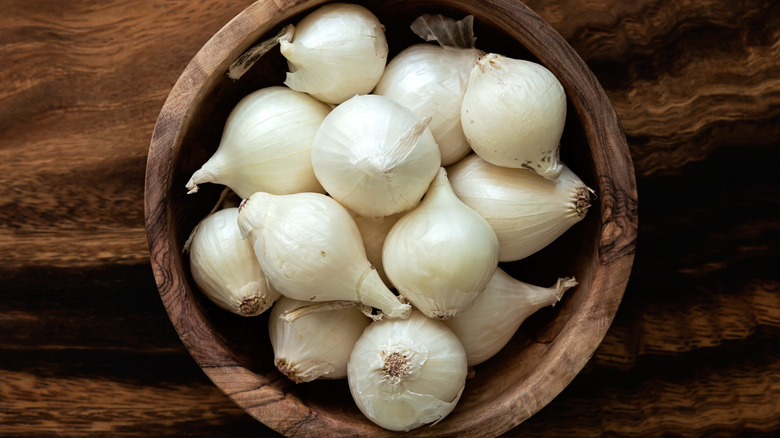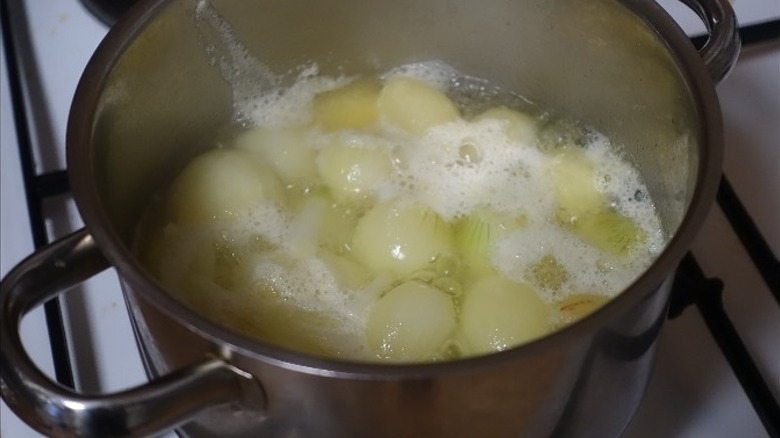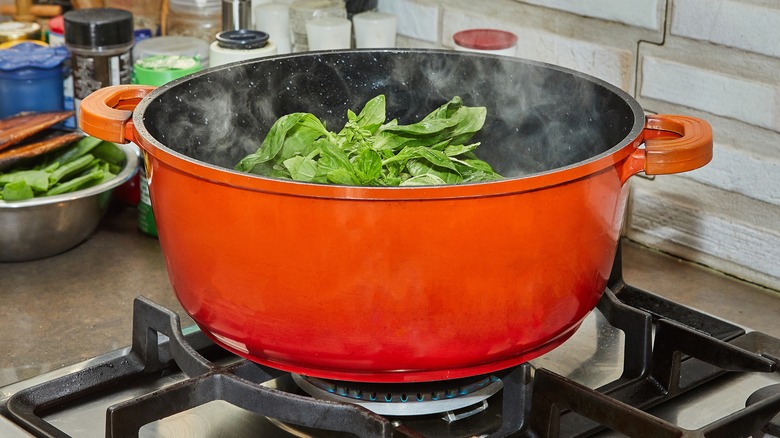The Easiest Way To Peel Pearl Onions In A Flash
Pearl onions are a small but mighty addition to any dish that calls for sweet onions. They can pack a massive flavor punch, but their small size can also make them seriously difficult to peel. The good news is, you never again have to spend a long time in the kitchen trying to meticulously peel your pearl onions.
There's a quick, easy way to get the job done, and all it requires is the use of your stove, a pot, a knife, a bowl, and some water. Blanching and shocking your unpeeled pearl onions is the quickest (and simplest) way to get that annoying peel off. Just boil the onions in water for a couple of minutes, bathe the hot onions in cold water, cut off the onion roots, and then squeeze the onion stems to release the unpeeled onions from their skins. This process doesn't take much time, so if you have to peel pearl onions in a hurry (or even if you're not in a rush), you can complete the process without much hassle.
How blanching helps peel pearl onions
It can be difficult to peel off skin in order to reach those flavorful inner onion layers you'll need for your recipes. However, blanching can help you easily remove your pearl onions' skin, thanks to the heat involved. Shocking the onions afterward just ensures those onions don't remain too hot.
When onions are boiled, the heat changes their structure on a micro-cellular level. The high temperature breaks down various structures in the onions' cells, so when you boil pearl onions, the heat softens them. It also loosens their skin much more quickly than your knife ever could on its own.
The second step, the onions' "bath" in cold water, is just as useful. Exposure to cold water will stop your onions from cooking. After that, all you have to do is cut and squeeze. Blanching and shocking pearl onions is a quick, productive way to use science in your kitchen.
Other reasons to blanch vegetables
While being able to peel pearl onions in minutes is undeniably cool, it's not the only benefit of blanching. Blanching can affect how clean your onions become, how nutritious they are, and even how bright they look when all's said and done. Reasons to blanch don't just extend to your pearl onions, either.
Blanching vegetables in general can get rid of stubborn, leftover grime and microorganisms, according to the Clemson University Cooperative Extension Service. Thus, your veggies will be squeaky clean when you eat them. Vegetables can also lose color when they're cooked, but the blanching process slows down the enzyme reactions that contribute to this color loss. Therefore, if you blanch your veggies, they'll look brighter when you plate them than if you hadn't. Additionally, cooking vegetables can cause them to lose some of their nutrients, but blanching can also help retain more of their vitamins, so you'll end up with healthier veggies than you might have otherwise. Ultimately, boiling (and shocking) pearl onions to remove their skin is far from the only perk that blanching has to offer your vegetables.


